|
|
|
Congress and Exhibition Venue
|
|

Budapest
Congress & World Trade Center
Address: 1123 Budapest, Jagelló u. 1–3.
Phone: +36 1 372 5400
Fax: + 36 1 466 5636
Map
- the largest conference facility in Hungary
- a place where the meetings can be organised in a dynamic and modern
environment
- during the 2005 refurbishment, the latest audio-visual, stage-,
light-, and air-conditioning technologies were built in
- BCWTC is connected to the Novotel Budapest Congress, which is
situated at a charming chestnut park
- has a good connection with the city centre and the historical part
of the city (the castle area)
|
| |
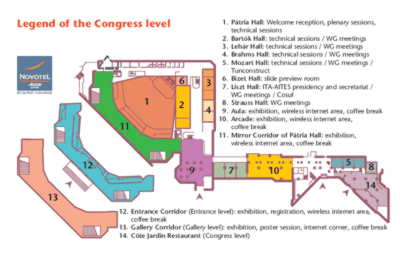
Click the
picture to view it in large |
|
|
A Few Words about Hungary
|
|
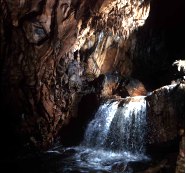 Hungary
is located in Central Europe, embraced by the arc of the Carpathians.
The landscape is dominated by plains and gentle hills of the Pannonian
Basin. Some mountains form 600–900 m high elevation ranges. The
landscape is characterized by temperate grasslands, agricultural lands,
meadows and non-coniferous forests. Two major rivers: the Danube and the
Tisza flow across the country from north to south and provide natural
links to the immediate neighbors and the more distant European partners.
Lake Balaton, the biggest still-water lake in Central Europe is a
favorite touristic target because of its warm water and nice landscape.
The geothermally hot Pannonian Basin provides excellent spas and cure
resorts for the country. There is a geological formation on the karstic
region of Aggtelek from the northern border of the country until Jósvafô.
The second biggest stalactite cave in Europe has been utilizing for
medicinal purposes for many years. It uses the medical effect of the
cave-air. The territory of the karstic cave-world was declared a World
Heritage site in 1995. Hungary
is located in Central Europe, embraced by the arc of the Carpathians.
The landscape is dominated by plains and gentle hills of the Pannonian
Basin. Some mountains form 600–900 m high elevation ranges. The
landscape is characterized by temperate grasslands, agricultural lands,
meadows and non-coniferous forests. Two major rivers: the Danube and the
Tisza flow across the country from north to south and provide natural
links to the immediate neighbors and the more distant European partners.
Lake Balaton, the biggest still-water lake in Central Europe is a
favorite touristic target because of its warm water and nice landscape.
The geothermally hot Pannonian Basin provides excellent spas and cure
resorts for the country. There is a geological formation on the karstic
region of Aggtelek from the northern border of the country until Jósvafô.
The second biggest stalactite cave in Europe has been utilizing for
medicinal purposes for many years. It uses the medical effect of the
cave-air. The territory of the karstic cave-world was declared a World
Heritage site in 1995.
|
| |
|
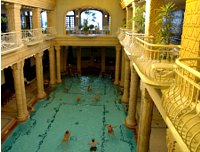 During
its more than 1000 years the Hungarian state has experienced every
possible historical sort. It was several times invaded by different
empires, coming from the east. It survived several subdivisions, lost
world wars, civil wars and revolutions. Today Hungary is a member of the
European Union. During
its more than 1000 years the Hungarian state has experienced every
possible historical sort. It was several times invaded by different
empires, coming from the east. It survived several subdivisions, lost
world wars, civil wars and revolutions. Today Hungary is a member of the
European Union.
Hungary has a slowly diminishing population of 10million. The capital:
Budapest is the most densely populated area with its 2 million
inhabitants. Several major cities of some 100,000 inhabitants are found
in county centers.
Cultural highlights as well as culinary interests are found everywhere
in the country. Nice museums, monuments, spas wait to be discovered in greater
cities, around Lake Balaton, in the Danube Bend and in the Puszta (Great
Hungarian Plain).
|
| |

Hungarian musical life became well-known and the Academy of Music has
been educating musicians not only for Hungary. The Academy of Music
was opened in Budapest in 1875, with Franz Liszt as its President
and Ferenc Erkel as Director. This institution has been the center of
Hungarian musical education ever since, and together with the
Philharmonic Society (since 1853) and the
Opera House of Budapest (since 1884) the workshop of Hungarian
artistic interpretation. There are festivals during the year, and a lot
of famous musicians make concerts from over all the world in Budapest.
|
| |
|
Destination Budapest
|
 Budapest
owes everything to the Danube. This majestic river, here in the middle
of Europe, has created history and exceptional beauty. Many of the
greatest rulers of history could not resist the temptation to try to
mould the city in their own image, which occasionally meant that some of
the finest buildings on either bank of the river were burnt to ashes or
reduced to rubble. The Danube tamed and smoothed out the eastern side of
the city, Pest, by simultaneously dividing and linking it to the wooded
hills of the western side. Budapest
owes everything to the Danube. This majestic river, here in the middle
of Europe, has created history and exceptional beauty. Many of the
greatest rulers of history could not resist the temptation to try to
mould the city in their own image, which occasionally meant that some of
the finest buildings on either bank of the river were burnt to ashes or
reduced to rubble. The Danube tamed and smoothed out the eastern side of
the city, Pest, by simultaneously dividing and linking it to the wooded
hills of the western side.
|
| |
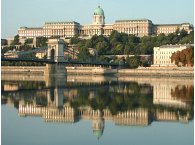 Budapest
is not an out-of-the way little town waiting to be discovered, it
reveals itself right from the start. It is a city that has always
attached great importance to its appearance, so that it would appear
hospitable and friendly at first sight. In a single glimpse the visitor
can see the World Heritage panorama with Parliament, the imposing Royal
Castle, Fisherman's Bastion, the impressive Danube Embankment in the
heart of the city and the bridges spanning the Danube. On Monday
morning, when people go to work, the city shows its other face. While
the tourists set out to explore Buda, Pest is pulling up its shutters
and the pedestrian street is beginning to bustle with life again. Budapest
is not an out-of-the way little town waiting to be discovered, it
reveals itself right from the start. It is a city that has always
attached great importance to its appearance, so that it would appear
hospitable and friendly at first sight. In a single glimpse the visitor
can see the World Heritage panorama with Parliament, the imposing Royal
Castle, Fisherman's Bastion, the impressive Danube Embankment in the
heart of the city and the bridges spanning the Danube. On Monday
morning, when people go to work, the city shows its other face. While
the tourists set out to explore Buda, Pest is pulling up its shutters
and the pedestrian street is beginning to bustle with life again.
|
| |
|
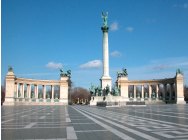 Many
people say that Many
people say that
Budapest is a city where the
most striking feature is the charm of its buildings, but at the same
time it is a real city of culture, a European city. Spending time in
Budapest affords a journey through time. In some areas, a stroll of
merely half kilometre is all that is needed to move from a dazzling
modern architectural feat of glass-metal-halogen to the astonishing
sight of a Roman monument dating back over a thousand years. Whatever
the era or architectural style may be, you are certain to find a
masterpiece of it in Budapest. Naturally, the history and the beauty of
the city is not all. The people living here create the soul of the city
and they have contributed to its vitality throughout the centuries.
Whether sitting in a quiet café over a pastry, admiring one of the
performances in the
Opera House or perhaps
relaxing in one of the numerous ancient thermal baths, it is easy for
one to observe how pleasantly the time passes in Budapest, the heart of
Europe.
|
|
|
Budapest and Hungary related links:
www.gotohungary.com
www.hungarytourism.hu
www.budapest.com
|
|
|